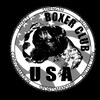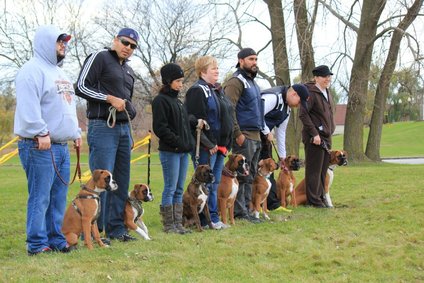
BOXER CLUB USA TRAINING
BOXER CLUB TRAINING ARTICLES:
We hope that you enjoy our Boxer training articles. Feel free to contact us with any training topic suggestions.
We hope that you enjoy our Boxer training articles. Feel free to contact us with any training topic suggestions.
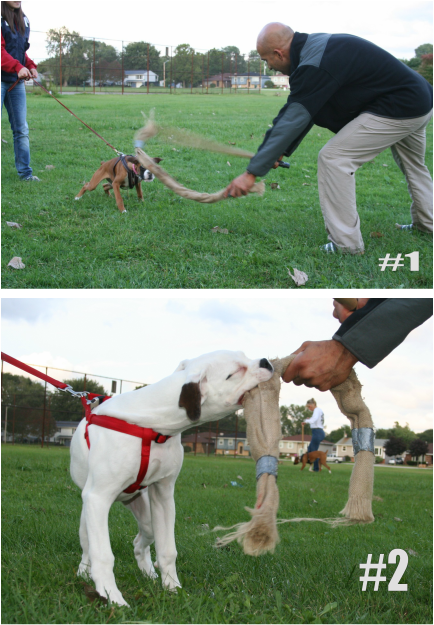
Evaluating an 11 week old boxer puppy.
Introduction and initial evaluation of the Working BOXER Puppy.
by adrian moreno
This segment was written as a basic "how to" begin a puppy in bite-work. Knowing how to start, what to look for, and how to develop a puppy is not only crucial but should be at the root of every working dog breeding program. Nothing makes me happier than to help build great dogs for the working dog sports.
As a decoy for Police & French RingSport, I have gotten the opportunity to evaluate hundreds of puppies and young dogs for these two disciplines. Even though both disciplines require slightly different attributes for success, I feel the correct BOXER temperament encompasses the criteria needed for both. For French Ringsport, I prefer a confident puppy with extreme drive to chase and for a Police k9 prospect, I like those same drives with an added element of dominance and independance in the pup. These qualities may lead to less points on the field but are necessary in a fight.
For all intensive purposes my explanations will be limited to the BOXER breed.
Test 1: TWO part test for prey and character:
Pre-bite stage/preparation:
Using an age appropriate target; I prefer to use a jute rag for dogs under three months of age. Jute's material is bite friendly and I accompany it by adding a clatter stick or what's called a baton in Ringsport. The baton is a bamboo lathe that is sliced in quarters. It'll clatter when shaken and is designed purposely to expose weaknesses in a dog's character by testing the nerves. In the Boxer, breeding for strong nerves should be a priority. Equipment needed for the puppy should always be a harness. Due to their sensitive nature and breathing disadvantage a harness is comfortable and doesn't inhibit the chase like a collar will. Collars will discourage a puppy from chasing almost immediately. Remember, we are talking about young pups here that need to be developed. Collars work great with older dogs, which if used should be no less than 2"wide to prevent choking. A boxer will not have the endurance to work like it's longer muzzled counterparts such as the Belgian Malinois, so take every precaution to enhance their working time on the field. The more time you have, the more you can get done.
As for the handler, he or she should be prepared to post up and handle the pup as if they were holding them on an elastic rubber-band. This will stop the puppy from coming to a shocking halt at the end of the lead. In my club, we use a rubber leash made by WACKY WALKER. This leash is perfect for novice handlers doing bite-work. The leash should always be taught when the puppy is learning to bite. This opposition will increase strength and grip as well as focus the pup on the bite.
b. Puppies that run from the clatter stick but chase the rag can be gradually introduced to the clatter stick as the decoy develops a stronger desire for the prize.
2. Decoy attitude and work: is done from a distance and it's important to show the dog the picture that he will see later in competition. In French Ringsport, the decoy is threatening and static; in Schutzhund, the helper is charging and driving forward. Initially, show these behaviors from a non-threatening distance when working a puppy in the pre-bite stages, which I refer to as the drive development stage. Drive development prepares the young pup for the training ahead, its preparing the student to "want to" work. I will adress this with more detail in the working of the young BOXER in later articles. For now, when the puppy makes contact or takes the target presented, the decoy should be weak and submissive to the young boxer. Refer to the picture #1 where decoy is exciting the pup and pairing the baton with chasing the rag. The decoy is always engaging him and pairing the baton with the fun of chasing. Once puppy takes hold, give reward with out a fight. As the prey response strengthens you can add the baton work. It's wise to keep the bation under or below the pup's eye level and shake only when the rag is being tugged by decoy. Refer to picture #2, if pups eyes close or winch during clattering, your baton work may be too strong so ease up on the clattering. Gradually build the baton by holding it still while you fight the pup a bit and build confidence through a victory (pic#).
by adrian moreno
This segment was written as a basic "how to" begin a puppy in bite-work. Knowing how to start, what to look for, and how to develop a puppy is not only crucial but should be at the root of every working dog breeding program. Nothing makes me happier than to help build great dogs for the working dog sports.
As a decoy for Police & French RingSport, I have gotten the opportunity to evaluate hundreds of puppies and young dogs for these two disciplines. Even though both disciplines require slightly different attributes for success, I feel the correct BOXER temperament encompasses the criteria needed for both. For French Ringsport, I prefer a confident puppy with extreme drive to chase and for a Police k9 prospect, I like those same drives with an added element of dominance and independance in the pup. These qualities may lead to less points on the field but are necessary in a fight.
For all intensive purposes my explanations will be limited to the BOXER breed.
Test 1: TWO part test for prey and character:
Pre-bite stage/preparation:
Using an age appropriate target; I prefer to use a jute rag for dogs under three months of age. Jute's material is bite friendly and I accompany it by adding a clatter stick or what's called a baton in Ringsport. The baton is a bamboo lathe that is sliced in quarters. It'll clatter when shaken and is designed purposely to expose weaknesses in a dog's character by testing the nerves. In the Boxer, breeding for strong nerves should be a priority. Equipment needed for the puppy should always be a harness. Due to their sensitive nature and breathing disadvantage a harness is comfortable and doesn't inhibit the chase like a collar will. Collars will discourage a puppy from chasing almost immediately. Remember, we are talking about young pups here that need to be developed. Collars work great with older dogs, which if used should be no less than 2"wide to prevent choking. A boxer will not have the endurance to work like it's longer muzzled counterparts such as the Belgian Malinois, so take every precaution to enhance their working time on the field. The more time you have, the more you can get done.
As for the handler, he or she should be prepared to post up and handle the pup as if they were holding them on an elastic rubber-band. This will stop the puppy from coming to a shocking halt at the end of the lead. In my club, we use a rubber leash made by WACKY WALKER. This leash is perfect for novice handlers doing bite-work. The leash should always be taught when the puppy is learning to bite. This opposition will increase strength and grip as well as focus the pup on the bite.
- The ideal response; for a puppy should be to perk up when the clatter stick is shaken. Decoys should never be in the pup's personal space during introduction to bitework. After clattering the baton and getting the pup's attention, it's time to begin throwing the rag around to test his prey drive. It's best if the handler doesn't allow the pup to win the prize, but only to chase and build frustration. A good puppy will immediately chase and become excited. Once you feel the dog's focus peaking, it's time to allow him to catch the prize. The rag is immediately released, giving the puppy confidence through success. The second and third bite can be now lengthened to a few seconds before surrendering the rag. A quality boxer puppy can easily do 4 to 6 bites before leaving the field. It is good to have them leave frustrated without the bite, but you can always change up and have them leave with their prize.
b. Puppies that run from the clatter stick but chase the rag can be gradually introduced to the clatter stick as the decoy develops a stronger desire for the prize.
2. Decoy attitude and work: is done from a distance and it's important to show the dog the picture that he will see later in competition. In French Ringsport, the decoy is threatening and static; in Schutzhund, the helper is charging and driving forward. Initially, show these behaviors from a non-threatening distance when working a puppy in the pre-bite stages, which I refer to as the drive development stage. Drive development prepares the young pup for the training ahead, its preparing the student to "want to" work. I will adress this with more detail in the working of the young BOXER in later articles. For now, when the puppy makes contact or takes the target presented, the decoy should be weak and submissive to the young boxer. Refer to the picture #1 where decoy is exciting the pup and pairing the baton with chasing the rag. The decoy is always engaging him and pairing the baton with the fun of chasing. Once puppy takes hold, give reward with out a fight. As the prey response strengthens you can add the baton work. It's wise to keep the bation under or below the pup's eye level and shake only when the rag is being tugged by decoy. Refer to picture #2, if pups eyes close or winch during clattering, your baton work may be too strong so ease up on the clattering. Gradually build the baton by holding it still while you fight the pup a bit and build confidence through a victory (pic#).
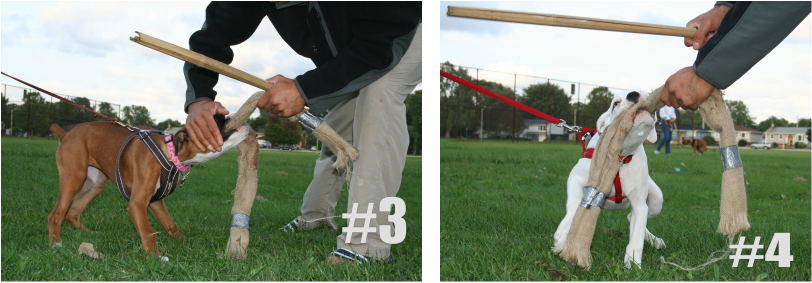
You can also view how the pup is being carressed in picture #3, the baton is being paired with stroking of the muzzle to reassure the young pup. In Picture #4, the baton is being held still while the decoy works the pup, the fight is soft and weak in the beginning but gradually builds over time. It doesn't take long before the puppy learns to anticipate the fight when a baton is present and they begin looking forward to the fight.
In time, the decoy may add glimpses of strength by challenging the puppy with static movement and false eye threats. These empty threats should be met with a strong countering response by the puppy. In time, you will build on these threats and lengthen the fight.
Decoy should take care to reward puppy by doing the following; releasing the rag for a strong counter grip, take stare away from pup, showing him your back as pup drags behind while on the bite.
From the initial work, you should be able to evaluate the puppy in the following;
1. Nerves- How does he react to the baton? Does he shy away, or run towards it with curiosity?
2. Prey Drive- Does he want to chase? is he afraid of the rag, timid, confident, or pronounced in drive?
3. Bite/Grip- was the bite shallow or deep, was it calm or hectic with head shake?
4. Decoy Contact- did he avoid contact and weaken grip or was he indifferent?
As you can see, there is much you can learn from this evaluation, a confident dog here will have similiar overlapping results in other evaluations.
I hope this segment has been insightful and helpful to your training. There is nothing more rewarding than developing a strong working foundation in a BOXER. Please forward any questions to [email protected] .
Happy Training,
Adrian Moreno
BOXER CLUB USA
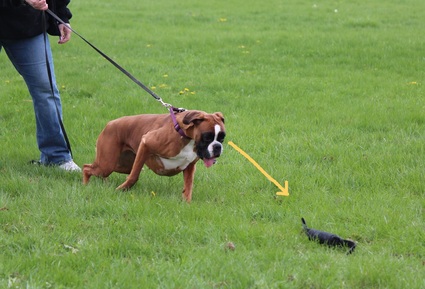
Introducing the Jambierre (a.k.a. Leg Sleeve) Part I
by Adrian Moreno
The leg sleeve can pose many problems to the BOXER, Especially ones with weak character but this holds true to any dog from any breed. This is why I make the leg a huge part of my BOXERS training regiment. Think of your dogs perspective when on a leg? it would be like having a dog target a bear's leg when he is standing on his hind legs. The dog naturally won't do it due to the imminent danger coming from the bears mouth and claws. A new decoy in trial, who is menacing would be a close #2, unless you prepare your dog with a quality foundation. So please keep this mind when training any new target. This article will explain the dog's preparation for the leg and the decoy' technical presentation of the leg, all in which I refer to as the pre-bite phase.
Before beginning your Leg training your dog must possess the desire to catch a tug. This is because a tug requires the dog to open his mouth wider than biting a rag which is necessary for grasping a leg. A leg is much wider than an arm. This dog must be truly committed to bite, therefore having good drive for work. If your dog hasn't reach this point, then I suggest you work on building your boxer before progressing to this lesson (Frustration Article/Enhancing Bite Drive).
The pics below depict a young boxer with the correct drives to bite. He has recieved good foundation work and is ready to take the leg sleeve. He shows no hesitation towards the menacing threats of the baton, and engages when the sleeve is presented. He is confident and wide eyed, he shows determination and focus on target. This is what is needed to proceed.
by Adrian Moreno
The leg sleeve can pose many problems to the BOXER, Especially ones with weak character but this holds true to any dog from any breed. This is why I make the leg a huge part of my BOXERS training regiment. Think of your dogs perspective when on a leg? it would be like having a dog target a bear's leg when he is standing on his hind legs. The dog naturally won't do it due to the imminent danger coming from the bears mouth and claws. A new decoy in trial, who is menacing would be a close #2, unless you prepare your dog with a quality foundation. So please keep this mind when training any new target. This article will explain the dog's preparation for the leg and the decoy' technical presentation of the leg, all in which I refer to as the pre-bite phase.
Before beginning your Leg training your dog must possess the desire to catch a tug. This is because a tug requires the dog to open his mouth wider than biting a rag which is necessary for grasping a leg. A leg is much wider than an arm. This dog must be truly committed to bite, therefore having good drive for work. If your dog hasn't reach this point, then I suggest you work on building your boxer before progressing to this lesson (Frustration Article/Enhancing Bite Drive).
The pics below depict a young boxer with the correct drives to bite. He has recieved good foundation work and is ready to take the leg sleeve. He shows no hesitation towards the menacing threats of the baton, and engages when the sleeve is presented. He is confident and wide eyed, he shows determination and focus on target. This is what is needed to proceed.
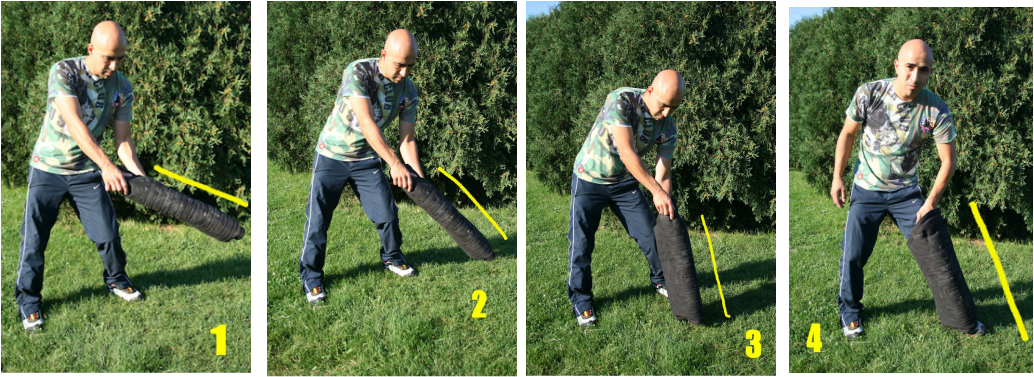
Introducing the Jambierre (a.k.a. Leg Sleeve) Part II
by Adrian Moreno
Let us discuss the challenges of taking the leg sleeve from the BOXER's point of view. One needs to know that Boxer was bred to hunt adversary that required it to be brave and courageous. Unlike the herding breeds, which were bred to work with domesticated sheep and fowl. The Boxer's ancestors had to tackle wild boar and later help the village butcher bring down the occasional bull. These dogs were bred for their tenacity to take their prey head on. Through selective breeding, the Boxer's technical grip was later promoted through todays sleeve sport such as Schutzhund. After countless of generations, the breed has developed a predisposition for a horizontal bite. Many fighting breeds I have worked seem to have this tendancy; American Pit BUll Terriers, American BullDogs, Argentine Dogo,etc. Therefore, when introducing the leg target, it is important to present in a way that is natural for the BOXER to understand it. Refer to pictures and notice how I follow a natural progression in my presentations. You will go through each stage as many times as you need to until you arrive at Picture 4. The Boxer should recieve a bite from each angle as you slowly move to a natural presentation. The dogs eyes should always be on the outside of the leg, this will avoid a nose bunt from the other leg when working as well as dangerous twisting of the neck when biting. Boxers that are well prepared with strong drives can adapt to decoy pressure when on the leg. So, foundation is key.
Video 1 demonstrates a dog with proper head placement.
Video 2 demonstrates a dog with high incorrect placement on the leg. The higher placement will add dificulty when boxer is working on the suit.
Video 3 demonstrates a boxer learning to target inner armpit. This is the ideal target for suit work.
(Footage compliments of Champ du Legendes Kennels at www.workingboxers.com )
by Adrian Moreno
Let us discuss the challenges of taking the leg sleeve from the BOXER's point of view. One needs to know that Boxer was bred to hunt adversary that required it to be brave and courageous. Unlike the herding breeds, which were bred to work with domesticated sheep and fowl. The Boxer's ancestors had to tackle wild boar and later help the village butcher bring down the occasional bull. These dogs were bred for their tenacity to take their prey head on. Through selective breeding, the Boxer's technical grip was later promoted through todays sleeve sport such as Schutzhund. After countless of generations, the breed has developed a predisposition for a horizontal bite. Many fighting breeds I have worked seem to have this tendancy; American Pit BUll Terriers, American BullDogs, Argentine Dogo,etc. Therefore, when introducing the leg target, it is important to present in a way that is natural for the BOXER to understand it. Refer to pictures and notice how I follow a natural progression in my presentations. You will go through each stage as many times as you need to until you arrive at Picture 4. The Boxer should recieve a bite from each angle as you slowly move to a natural presentation. The dogs eyes should always be on the outside of the leg, this will avoid a nose bunt from the other leg when working as well as dangerous twisting of the neck when biting. Boxers that are well prepared with strong drives can adapt to decoy pressure when on the leg. So, foundation is key.
Video 1 demonstrates a dog with proper head placement.
Video 2 demonstrates a dog with high incorrect placement on the leg. The higher placement will add dificulty when boxer is working on the suit.
Video 3 demonstrates a boxer learning to target inner armpit. This is the ideal target for suit work.
(Footage compliments of Champ du Legendes Kennels at www.workingboxers.com )
